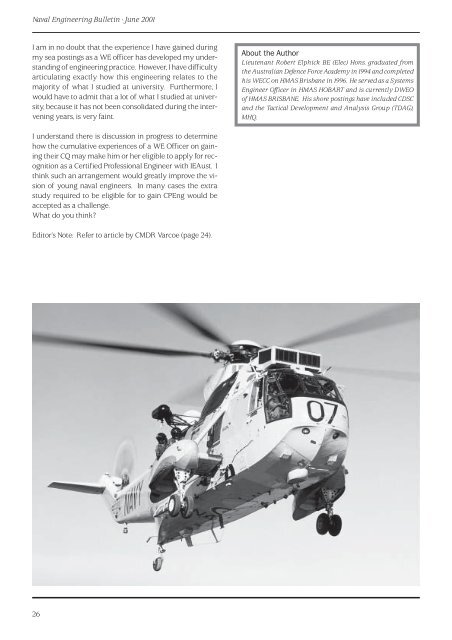Engineering - Royal Australian Navy
Engineering - Royal Australian Navy
Engineering - Royal Australian Navy
You also want an ePaper? Increase the reach of your titles
YUMPU automatically turns print PDFs into web optimized ePapers that Google loves.
Naval <strong>Engineering</strong> Bulletin • June 2001<br />
I am in no doubt that the experience I have gained during<br />
my sea postings as a WE officer has developed my understanding<br />
of engineering practice. However, I have difficulty<br />
articulating exactly how this engineering relates to the<br />
majority of what I studied at university. Furthermore, I<br />
would have to admit that a lot of what I studied at university,<br />
because it has not been consolidated during the intervening<br />
years, is very faint.<br />
About the Author<br />
Lieutenant Robert Elphick BE (Elec) Hons. graduated from<br />
the <strong>Australian</strong> Defence Force Academy in 1994 and completed<br />
his WECC on HMAS Brisbane in 1996. He served as a Systems<br />
Engineer Officer in HMAS HOBART and is currently DWEO<br />
of HMAS BRISBANE. His shore postings have included CDSC<br />
and the Tactical Development and Analysis Group (TDAG),<br />
MHQ.<br />
I understand there is discussion in progress to determine<br />
how the cumulative experiences of a WE Officer on gaining<br />
their CQ may make him or her eligible to apply for recognition<br />
as a Certified Professional Engineer with IEAust. I<br />
think such an arrangement would greatly improve the vision<br />
of young naval engineers. In many cases the extra<br />
study required to be eligible for to gain CPEng would be<br />
accepted as a challenge.<br />
What do you think?<br />
Editor’s Note: Refer to article by CMDR Varcoe (page 24).<br />
26
















